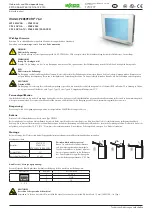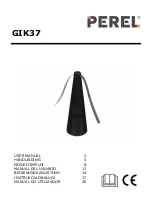
7
GDED-IOM-215-A
user shall understand which method is being used and who is responsible for the design
and supply of the equipment required. When an explosive dust has been properly identified
to AAF, the dust collector may be structurally designed to withstand the internal pressure
generated during the explosive event and fitted with an explosion vent, or with multiple
vents, designed to safely discharge the pressure and the resulting fireball. The user shall
review the purchase order and the documents referenced within it to determine if explosion
protection equipment has been supplied by AAF International. Where this is the case, review
the appropriate sections of this manual that deal with the installation, operation and
maintenance of the equipment ordered.
When explosion protection systems are supplied by multiple vendors, it is the
responsibility of the user to coordinate between suppliers to ensure that the equipment
supplied by each vendor will work together to achieve the required protection. For instance,
if an explosion suppression system is being supplied by parties other than AAF, it is
incumbent on the user to ensure that the dust collection equipment has been ordered to
resist the internal pressure defined by the suppression equipment supplier.
Dust collectors fitted with explosion vents must not be located indoors, unless
properly designed in accordance to NFPA regulations. The equipment shall be oriented so
that the vent will discharge to an unoccupied zone. Such a zone will be prohibited to
personnel and shall not include critical equipment or services such as fuel storage tanks,
flammable materials, fire hydrants, power distribution or electrical control equipment, or
similar. If the vent(s) is/are located on the side(s) of the equipment the vent discharge area
shall be isolated with barriers erected to prevent the parking of vehicles, pedestrian use,
use of the area for temporary storage, etc. Warning signs shall be posted. Include diagrams
showing the distribution of a typical dust explosion discharge.
2.4
Electrical hazards
Before doing any work on the AAF equipment make sure that all potential electrical
hazards have been identified and that all electric current connected to the equipment, and
to any connected or associated equipment, has been properly disconnected and securely
locked-out to prevent accidental reconnection prior to completion of the work. All electrical
work shall be done in full accordance with the current edition NFPA 70, the National Electrical
Code, and all other applicable laws, rules, and regulations. All electrical work shall be
performed by a licensed electrician. Only original AAF parts shall be used as replacements
for ongoing maintenance and repair.
2.5
Rotating Equipment
The OptiFlo RC can include a fan which is installed with the dust collector. The fan
wheel rotates and has the potential to cause severe injury. The fan wheel could be accessed
from outside the housing through the fan discharge. All due care should be exercised to
Содержание OptiFlo RC Series
Страница 1: ...GDED IOM 215 A OptiFlo RC...







































